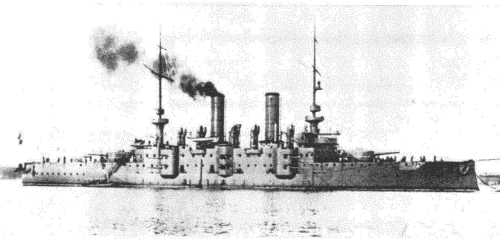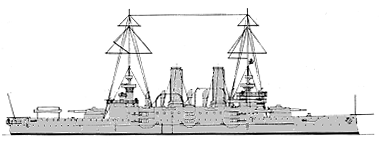
NAVYPEDIA
 Support the project with paypal
Support the project with paypal
Photo

Habsburg 1902 Many thanks to Wolfgang Stöhr for additional information on this page.
Ships
| Name | No | Yard No | Builder | Laid down | Launched | Comp | Fate |
|---|---|---|---|---|---|---|---|
| Habsburg | 323 | STT, San Marco | 13.3.1899 | 9.9.1900 | 31.12.1902 | to United Kingdom 1920, BU | |
| Árpád | 324 | STT, San Marco | 10.6.1899 | 11.9.1901 | 15.6.1903 | to United Kingdom 1920, BU | |
| Babenberg | 325 | STT, San Marco | 19.1.1901 | 4.10.1902 | 15.4.1904 | to United Kingdom 1920, BU |
Technical data
| Displacement normal, t | Habsburg, Babenberg: 8823 Árpád: 8748 |
|---|---|
| Displacement full, t | |
| Length, m | 114.6 oa 113.1 wl |
| Breadth, m | 19.9 |
| Draught, m | 7.46 |
| No of shafts | 2 |
| Machinery | 2 4-cyl VTE, 16 Belleville boilers |
| Power, h. p. | 15000 |
| Max speed, kts | 19.5 |
| Fuel, t | coal 840 |
| Endurance, nm(kts) | 3600(10) |
| Armour, mm | belt: 220-180, turrets: 280-210, casemates: 210, deck: 40, CT: 200 |
| Armament | Habsburg, Árpád: 1 x 2 - 238/37 K. L/40 K.94, 1 x 1 - 238/37 K. L/40 K.94, 12 x 1 - 149/37 G. L/40 K.96, 10 x 1 - 66/42 SFK L/45, 6 x 1 - 47/40 SFK L/44 S, 2 x 1 - 47/30 SFK L/33 H, 2- 450 TT (beam) Babenberg: 1 x 2 - 238/37 K. L/40 K.97, 1 x 1 - 238/37 K. L/40 K.97, 12 x 1 - 149/37 G. L/40 K.96, 10 x 1 - 66/42 SFK L/45, 6 x 1 - 47/40 SFK L/44 S, 2 x 1 - 47/30 SFK L/33 H, 2- 450 TT (beam) |
| Complement | 638 |
Standard scale images

Habsburg 1903
Graphics
Project history
With this class the Austrian Navy acquired its first seagoing battleships since the Tegetthoff, even though they were the smallest in existence. If Popper had been allowed a few more tons, these ships would have been equal to if not better than their contemporaries. In 1910/11 Habsburg and Árpád had one superstructure deck removed to save topweight.
Ship protection
Main deck protected the hull from some fwd from fwd barbette to some aft from aft barbette (68m or 62% of ship length) and extended from 1.1m above wl to 1.4m under wl. The belt consisted of two strakes: 220mm upper (1.5m wide) and 180mm lower (1m wide). Armour plates were backed by 180mm (upper)-220mm(lower) teak. The belt was closed by 200mm fwd and aft bulkheads. Upper belt had 50mm thickness aft of aft barbette. The 40mm medium deck between barbettes was connected with upper edge of main belt. Lower deck outside the citadel had turtleback form and 60mm thickness fwd and 66mm aft. 100mm upper belt between the barbettes was closed by 100mm bulkheads. 15cm guns were protected by own individual casemates protected by 135mm faces and sides and 60mm rears and had also 100mm shields. Barbettes were 210mm above the upper deck (180mm rears) and 135mm between upper and medium decks. Turrets had 200mm faces and sides, 150mm rears and 50mm crowns. Main CT had 200mm sides, aft CT had 100mm sides. Communication tubes had 150mm (fwd) or 50mm (aft) protection.
Modernizations
1916-1917, all: + 2 x 1 - 66/42 G. L/45 BAG
Naval service
Later in the war all three ships were decommissioned and served as harbour guard ships. All were ceded to Great Britain in 1920 and scrapped in Italy in 1921.
Many thanks to Wolfgang Stöhr for additional information on this page.
 HOME
HOME FIGHTING SHIPS OF THE WORLD
FIGHTING SHIPS OF THE WORLD AUSTRIA-HUNGARY
AUSTRIA-HUNGARY CAPITAL SHIPS
CAPITAL SHIPS HABSBURG battleships (1902-1904)
HABSBURG battleships (1902-1904)
